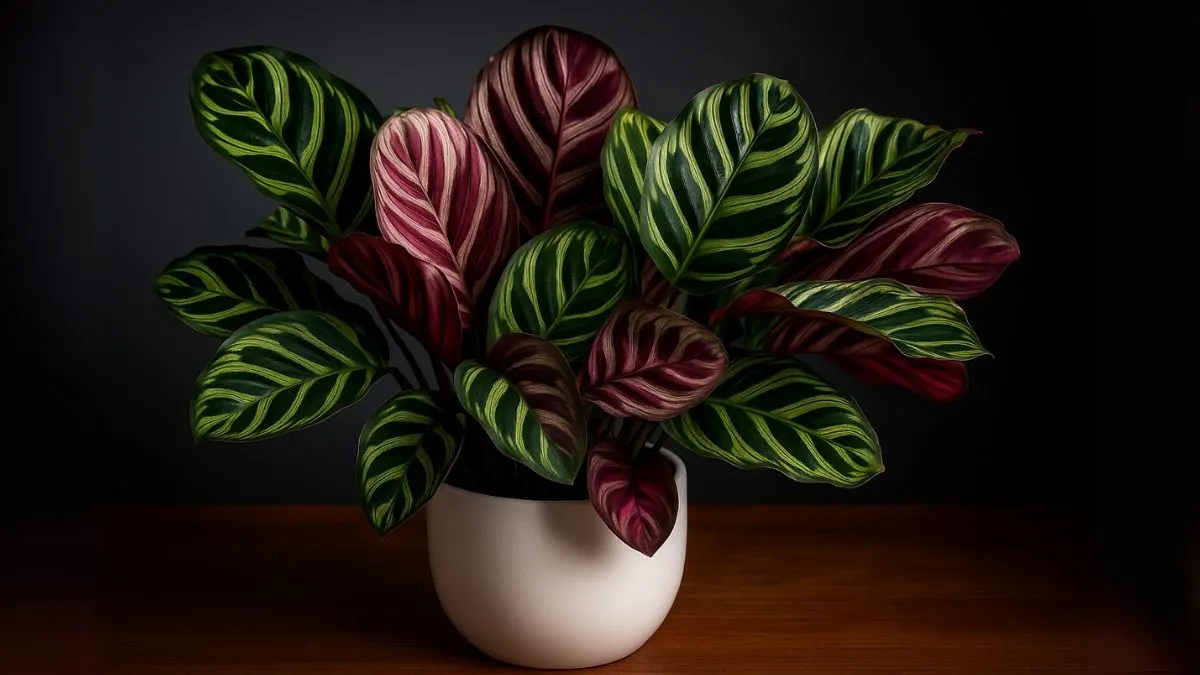If there’s one plant that turns heads every time someone walks into a room, it’s the Peacock Plant. With its striking patterns of green, cream, and purple, this tropical wonder looks like an artist painted delicate feathers on each leaf. It’s not just a stunning indoor plant—it’s a living piece of art.
As someone who first added a Peacock Plant to my windowsill garden during a Canadian winter, I quickly realized why it’s adored across the world. It brings warmth, vibrancy, and elegance, especially when the outdoors feel cold and gray.
What is the Peacock Plant?

The Peacock Plant is a species of plant belonging to the genus Goeppertia (previously categorized under Calathea). Native to the rainforests of Brazil, it thrives in warm, humid conditions, making it perfect for indoor spaces where you can mimic its natural environment.
It’s usually grown as a houseplant year-round, especially in cooler countries like Canada, USA, and the UK, where outdoor survival is challenging during winter.
Why It’s Called the Peacock Plant
The name comes from its breathtaking foliage. Each leaf is broad, oval, and marked with patterns that look like the vibrant feathers of a peacock. The tops are decorated with shades of light and dark green, while the undersides shine with rich purple.
It’s no wonder many gardeners call it an elegant indoor plant with stunning foliage resembling the feathers of a peacock—because that’s exactly what it feels like having in your home.
Also Read: Jade Plant Lifespan: How Long Can This Hardy Succulent Live?
Light Requirements
Like many tropical houseplants, Peacock Plants prefer softer light conditions.
- Place your plant in bright, indirect light.
- Avoid harsh afternoon sun, which can scorch the leaves.
- A north- or east-facing window works best.
I keep mine near a window filtered with sheer curtains, and the leaves remain healthy and vibrant throughout the year.
Soil and Watering
Getting soil and moisture right is crucial for this plant’s survival.
- Soil: Use a loamy, well-draining mix rich in organic matter.
- Moisture: Always keep soil moist, but never soggy. Overwatering can cause root rot.
- Humidity: Since it’s native to rainforests, it loves high humidity. A humidifier or a pebble tray will keep it thriving.
Tip: During my early days of care, I noticed leaf edges browning. Once I increased humidity with a small indoor humidifier, my Peacock Plant bounced back beautifully.
Temperature and Climate Needs
The Peacock Plant flourishes in environments between 60–75°F (15–24°C).
- Protect it from cold drafts during winter.
- Keep it away from air conditioners and heaters, which dry out the air.
- In tropical countries, it grows easily outdoors, but in North America, it’s strictly an indoor star.
Also Read: Pothos Plant: The Easiest Indoor Plant You’ll Ever Grow
Care and Maintenance Tips
Caring for this beauty is easier than you think.
- Mist leaves regularly.
- Feed it monthly during spring and summer with a diluted liquid fertilizer.
- Repot every 2–3 years to refresh soil and give roots room to expand.
- Remove dead leaves to encourage fresh growth.
Common Problems and Solutions
Even the most stunning indoor plant comes with challenges.
- Curling Leaves: Usually caused by low humidity. Mist or humidify.
- Yellow Leaves: Overwatering or poor drainage. Improve soil conditions.
- Pale Foliage: Too much direct light. Move it to filtered light.
Quick Care Summary Table
Care Factor |
Requirement |
Light |
Bright, indirect light |
Soil |
Loamy, well-draining |
Watering |
Keep soil moist, not soggy |
Humidity |
High (use humidifiers or pebble trays) |
Placement |
Indoor, year-round |
Special Feature |
An elegant indoor plant with stunning foliage resembling the feathers of a peacock |
Why It’s Famous Worldwide
The Peacock Plant is usually grown as a houseplant year-round, making it popular in Canada, USA, and Europe where winters are harsh. Plant enthusiasts love it because it adapts beautifully to indoor spaces and provides a tropical vibe even in the coldest months.
Its exotic appeal, combined with air-purifying properties, makes it a go-to plant for modern homes and offices.
Also Read: How to Plant and Grow a Garden Coconut Tree
Personal Experience
When I brought my first Peacock Plant home, I was nervous about its care. Within days, I noticed the leaves folding up at night—a natural behavior that adds even more charm. With a humidifier, indirect light, and regular misting, it grew beautifully, and now it’s the centerpiece of my indoor plant collection.
If you want to add an elegant indoor plant with stunning foliage resembling the feathers of a peacock to your home, this is the perfect choice. Just remember to keep soil moist, provide indirect light, and maintain humidity—and you’ll enjoy its beauty for years to come.






